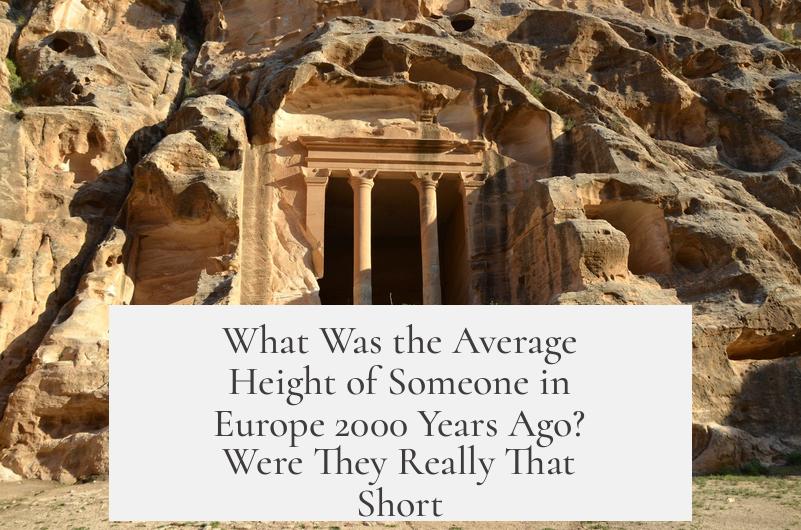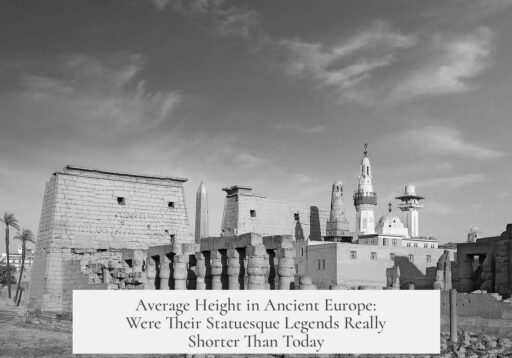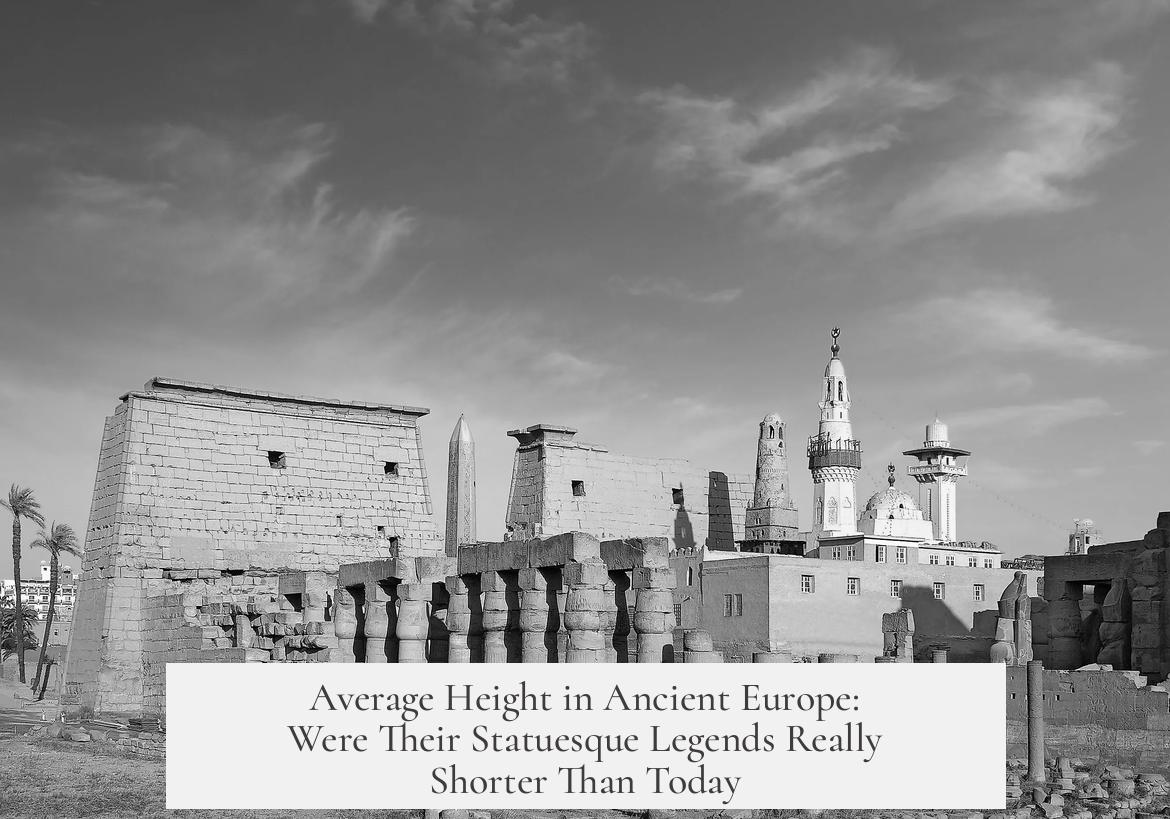The average height of people in Europe 2000 years ago was not uniformly shorter than modern populations. Evidence shows significant variation across regions and social groups, with some ancient populations’ stature comparable to or even exceeding that of many today.
Roman sources mention the exceptional height of some Germanic tribesmen, often described as towering figures. These observations align with archaeological discoveries where remains of certain northern European groups measured between 1.70 to 1.85 meters (5’7″ to 6’1″). For comparison, average modern European male heights typically range from 1.75 to 1.85 meters. This indicates that at least some ancient Europeans were as tall as modern individuals.
Height variation in ancient Europe depended on several factors. Genetics played a role, with taller individuals more common in northern Europe compared to the south—a pattern consistent today. Genetic factors provided the potential height range, but environmental influences, especially diet, largely determined actual adult stature.
Nutrition was the primary factor influencing growth in the past. Populations with access to diverse and plentiful food sources, such as meat, fish, and dairy, tended to be taller. In contrast, poorer individuals or groups reliant on limited, repetitive diets experienced stunted growth. For example, Roman peasants often had less nutritious diets, causing shorter average heights than more affluent or northern groups subsisting on richer fare.
Social stratification impacted height as well. Archaeological samples are biased toward wealthier individuals, who received more elaborate burials and are therefore more likely to be discovered and studied. Since socially elite people generally had better nutrition, their remains often show taller statures compared to the general population. This bias means excavated remains may not represent the true average height of the entire population 2000 years ago.
Historical figures illustrate height variation too. Charlemagne reportedly stood over 2 meters tall (about 6’8″), an uncommon height even today. Similarly, the Cimbri, a Germanic tribe mentioned in Roman accounts from that era, averaged around 2 meters. Such examples confirm that some individuals and groups reached impressive stature, contradicting the stereotype that ancient people were uniformly short.
The shift to an agricultural lifestyle played a critical role in average height trends. Early agriculturalists often depended heavily on a few staple crops. This limited diet reduced essential nutrients, leading to shorter stature and decreased life expectancy compared to hunter-gatherer societies. Many prehistoric hunter-gatherer populations were taller and lived longer than early farmers, demonstrating the nutritional impacts of dietary changes.
Climate also influenced body size and proportions. Human populations in colder environments tended to evolve shorter, stockier bodies, which conserved heat more efficiently. Conversely, groups in warmer climates developed taller, leaner frames to dissipate heat. These climatic adaptations affected height alongside other factors.
| Factor | Effect on Height 2000 Years Ago |
|---|---|
| Genetics | Set potential height ranges; northern Europeans generally taller. |
| Diet & Nutrition | Primary determinant of actual height; poor diets led to shorter stature. |
| Social Status | Elite individuals typically taller due to better nutrition. |
| Archaeological Bias | Samples favor taller, affluent individuals. |
| Agriculture | Reduced dietary variety, lowering average height. |
| Climate | Cold climates favored shorter, stockier bodies; warm climates taller, leaner builds. |
Modern average heights have generally increased due to improved nutrition, healthcare, and living conditions. Yet, the idea that ancient Europeans were universally shorter is inaccurate. Some groups and individuals matched or surpassed modern height, while others, particularly underprivileged populations or those affected by famine, were shorter.
In sum, height 2000 years ago varied widely. Genetic predisposition and environment both mattered. Nutrition, social structure, and climate shaped stature more than time alone. The historical record shows that ancient stature often rivaled modern figures, challenging simplistic views of past populations as significantly shorter.
- Some ancient Europeans, especially Germanic groups, were as tall as modern populations.
- Diet and social status strongly influenced height differences then and now.
- Archaeological remains bias height data toward taller, wealthier individuals.
- The advent of agriculture generally reduced average height due to less varied diets.
- Climate shaped body proportions impacting stature across regions.
What Was the Average Height of Someone in Europe 2000 Years Ago? Were They Really That Short?

To answer the burning question head-on: No, the average European 2000 years ago wasn’t significantly shorter than today’s populations. The picture isn’t as simple as “everyone was tiny.” In fact, height varied a lot, depending on genetics, diet, and social status. Let’s dig deep into this human growth story.
Height in ancient Europe wasn’t set in stone. Instead, it bounced around like a game of genetic and environmental pinball. If you imagine your ancestor walking down a Roman street or wandering Germanic forests, their height could be within striking distance of our modern range.
Genetics and Geography: The Blueprint of Height
First up, genes play a starring role. Even today, northern Europeans tend to be a bit taller than their southern neighbors. This pattern held true 2000 years ago, too. It means if you were a Celt in northern Gaul, you might have had a natural edge over a Roman citizen from Italy.
Genetics laid the groundwork for how tall people could get. But environmental factors usually decided whether you reached that potential. So, even if your genes said “tall,” bad luck wouldn’t let you grow much. This ties directly into diet and social class.
The Role of Bread and Butter (or Lack Thereof)
Nutrition was king—or queen—when it came to height. The past’s real troublemaker was famine or food scarcity, especially during youth or mom’s pregnancy. A poor Roman, struggling to eat a varied diet, often ended up shorter.
Compare that to a Scandinavian who lived off fish, meat, and dairy products. That diet offered more protein, vitamins, and calories, supporting better growth. So, even within the same region, heights could vary widely depending on what people ate.
Think of it as the ancient equivalent of the “eat your veggies” lecture. The Romans weren’t eating sushi with kale and quinoa, but their diet could be limited, especially for lower classes, creating a height gap driven by social stratification.
Social Status: Your Height Could Tell Your Story
Speaking of social class, archaeology reveals an interesting bias. Wealthier folks were buried more elaborately, which makes their remains easier to find. This means taller individuals from the upper classes get more attention in historical records.
The typical Roman soldier or elite might show a taller stature than the everyday laborer or peasant. Excavations of 1st century BC Danish warrior graves show men ranging from 1.70 to 1.85 meters (5’7” to 6’1”), which is no small fry.
It’s like history’s version of favoring the popular kids in the yearbook photo. The gladiator or warrior might have been taller than average, but that doesn’t mean everyone was a giant.
Famous Examples: Giants of the Past

And yes, there were some genuine giants. Charlemagne, for example, wielded a suit of armor from a heroic 2 meters-plus height (around 6 feet 8 inches). That’s impressive even by today’s standards.
Then there were the Cimbri, a tribe famed by Roman historians for towering at nearly 2 meters tall. What’s fascinating is that even during times of famine, some groups maintained great height, probably due to genetic and environmental factors combined.
Agriculture and Its Impact on Human Growth
The move to farming was a double-edged sword. While agriculture supported larger populations, it also meant more limited diets—mostly grains. This caused problems for growth and life expectancy. The stereotype of short, sickly ancient folks popped up post-agriculture.
Pre-agricultural hunter-gatherers, on the other hand, often reached their full height potential and had longer lifespans, rivaling some modern hunter-gatherer groups. They had diverse, protein-rich diets and fewer societal limits on food access.
Climate’s Role Behind the Scenes
Climate nudged human forms in particular directions. In colder places, people tended to be shorter and stockier to conserve heat. Warm climates encouraged tall and lanky builds to shed heat more easily.
This wasn’t a hard-and-fast rule, but it influenced body shapes and sizes across Europe’s varied environments 2000 years ago. It explains why height wasn’t uniform everywhere.
Summing Up: Were Ancient Europeans Shorter?
Simple answer: No. But with lots of fine print.
Height varied based on a cocktail of factors—genetics laid the foundation, diet during childhood and pregnancy determined if you reached your potential, social status influenced who got what kind of nutrition, and geography shaped body types biologically adapted to climate.
People from northern Europe like ancient Danes or Germanic tribes could be as tall as modern Europeans, some even taller. On the flip side, poor Romans relying heavily on grain diets and experiencing food shortages tended to be shorter.
This means the myth of universally tiny ancients is just that: a myth. Many stood surprisingly tall. Some were giants for their times, while others fell short due to lifestyle and chance.
Practical Takeaway for Modern Readers
If you’re interested in human height or just want to impress at your next trivia night, remember: height reflects health and environment, not just genes. Even today, nutrition and social factors play massive roles.
Studying ancient heights teaches us about the conditions our ancestors faced and highlights how much modern living has improved nutrition and health care.
So, next time you feel short on your morning coffee, imagine a 2-meter tall warrior from Denmark and remember—that ancient height variation might be closer to your own than you think!




